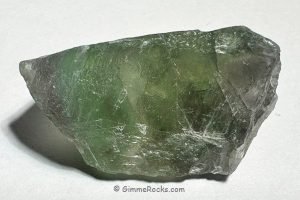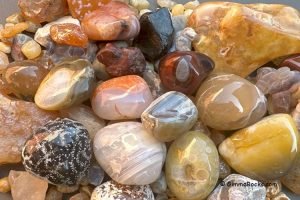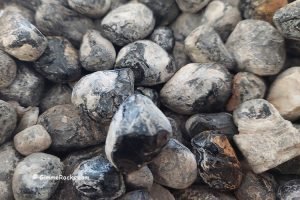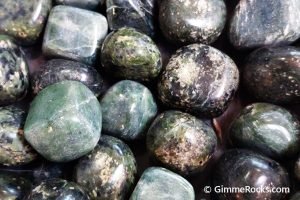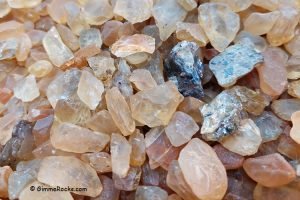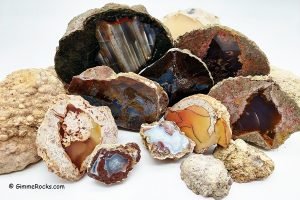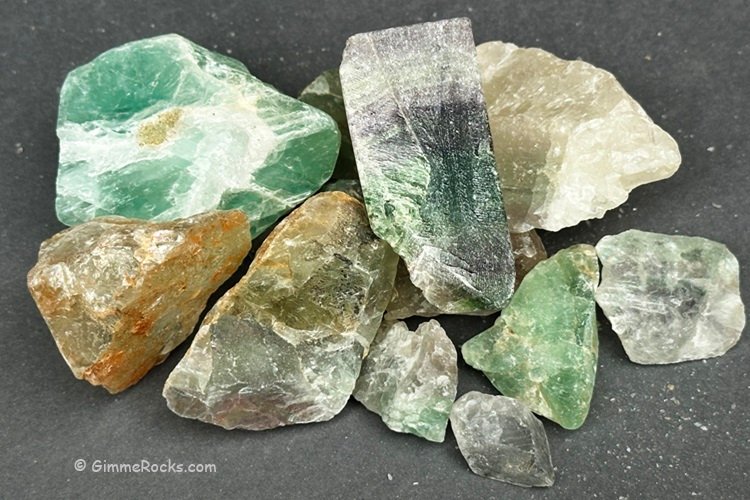
Fluorite is a stunning mineral that occurs as well-formed crystals in various colors. While most frequently purple, fluorite crystal can take on various other hues, including green, yellow, and a combination of colors. These color variations result from impurities and crystal defects, known as color centers. A color center is a point within the crystal where the atomic structure is slightly irregular. These defects alter how the crystal absorbs and reflects light, which leads to that captivating range of colors one can observe in a fluorite.
In addition to its breathtaking colors, fluorite crystals emit a bright glow under ultraviolet (UV) light. That light typically comes in shades of blue, green, or purple, which, again, depends on impurities within the crystal.
This phenomenon is called fluorescence. As you can probably guess, it was named after fluorite because it was one of the first minerals in which this characteristic was observed. In the past, fluorite used to go under a different name – Fluorspar. The term fluorspar is now used to refer to the bulk stone.
When fluorite breaks, it exhibits a perfect cleavage (the tendency of a mineral to break along flat, planar surfaces) in four directions, often forming triangular or octahedral shapes.
This property and its relative softness (4 on the Mohs scale) make fluorite easily distinguishable from other minerals, such as quartz or calcite.

Yttrofluorite and Yttrocerian Fluorite - A Rare Variety
Fluorite is typically pure, but sometimes up to 1/5 of calcium in its crystal structure may be replaced with rare-earth elements such as yttrium and cerium. That tends to give the mineral a yellow, brown, or green hue.
Yttrium-rich fluorite is called yttrofluorite. Yttrium- and cerium-rich fluorite is yttrocerian fluorite. Both varieties are found in granitic pegmatites, hydrothermal veins, and alkali-rich environments. Scientists and collectors value these fluorites immensely for their scientific significance and aesthetic appeal.
Fluorite Crystal Formation
Fluorite forms in various geological environments, making it one of the most widespread minerals on Earth. It occurs in hydrothermal veins and pockets, often associated with other minerals like quartz, calcite, barite, and sulfides.
Mineral-rich fluids flow through cracks in the rocks, depositing fluorite crystals as temperature and pressure change. Fluorite often forms in metal-rich veins with lead and silver ores. These areas create ideal conditions for fluorite crystals to grow.
In some cases, fluorite forms in limestone beds or around hot springs. It can also crystallize in granitic pegmatites or cavities within igneous rocks.
Specific environments in which fluorites form dictate each mineral's unique properties, shape, and color. Found in hydrothermal veins, sedimentary deposits, and even metamorphic rocks, fluorite takes on a variety of appearances depending on factors such as temperature, pressure, and the presence of other minerals.
For example:
- Southern Illinois: Fluorite forms in thick veins within limestone, often producing colorful, well-formed crystals.
- Swiss and French Alps: Pink to red octahedral fluorites grow in alpine clefts alongside smoky quartz.
- India: Lemon-yellow, botryoidal fluorites form as grape-like clusters in cavities.
Guide to Fluorite Identification
You can recognize fluorite by its appearance. The combination of color, harness, cleavage, fluorescence, and crystal habit distinguishes fluorite from other minerals.
It typically forms cubic or octahedral crystals, often sharp and well-defined. Specimens can be transparent to translucent. High-quality specimens are often clear with vibrant colors. Color zoning or banding is frequently present.
Common Fluorite Colors
Fluorite has the widest color range among most minerals. It comes in a wide variety of colors—purple, green, yellow, blue, or in rarer pink and red hues—often due to trace elements or radiation exposure.
Multicolored (rainbow) specimens can form if, during their development, the growing fluorites get exposed to varying environmental conditions. Colorless and transparent specimens are those free of trace elements.
Fluorite Texture
Fluorite tends to be smooth and has a vitreous (glass-like) luster. Even though it may feel solid, fluorite is, in fact, pretty soft and prone to scratching. Handle it gently and with care. Fluorite's perfect cleavage means that it is very easy to chip or break.
Hardness Test
Fluorite is a soft mineral with a hardness level of 4 on the Mohs scale. This means that a glass plate or a pocket knife (with a hardness of 5.5) will leave scratches on its surface. Flourite, in turn, will leave scratches on a copper penny, which has a lower hardness of 3.5.
Cleavage
Fluorite exhibits perfect octahedral cleavage (breaks along smooth planes). Cleavage fragments are often cubic.
Optical Properties
Fluorite is famous for its fluorescence under ultraviolet (UV) light. Depending on the impurities in the specific fluorite, it may glow blue, green, or purple. Those are the most common colors -- although other colors, such as white or red, may occur.
Some specimens display thermoluminescence (glowing when heated), phosphorescence (glowing in the dark after UV exposure), or triboluminescence (flashes of light when crushed or scratched).
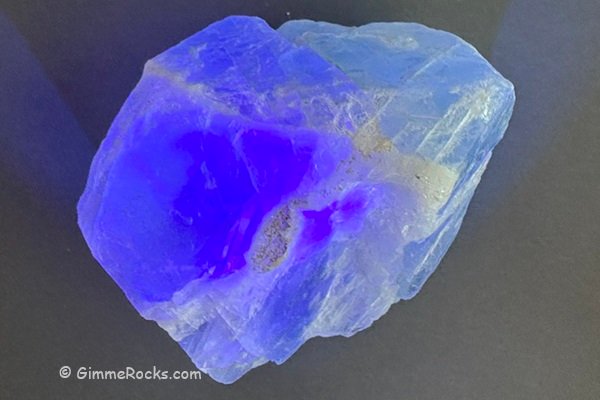
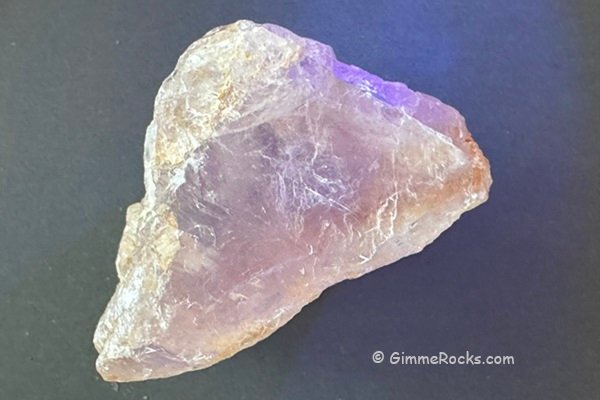
Occurrence of Fluorite
Fluorite can be found in many locations around the world. Here are some of the best-known deposits:
The United States
- Arizona: Fluorite are typically purple, green, or colorless and found in Cochise, Maricopa, and Yavapai Counties.
- California: It occurs in veins and hydrothermal deposits in locations like the Mojave Desert and the southern Sierra Nevada. The colors of the minerals range from pale blue to green. Some areas also produce striking cubic crystals.
- Illinois: Illinois is famous for its fluorite mining, particularly in the southern part of the state around the Rosiclare and Cave-in-Rock. Known for vibrant purple and blue specimens, Illinois fluorite often exhibits excellent fluorescence and cubic crystal formations.
- New Mexico: Fluorite crystals here are typically deep purple or violet. They tend to be found in Lincoln, Luna, and Socoro Counties.
- Ohio: The minerals occur in cavities and dolostones' fractures along the Findlay Arch's crest in northwestern Ohio.
Other Countries
- Canada: In Ontario, fluorites are scattered across the hills, mountains, and plains.
- England: The North Pennines (Cumbria) and Castleton (Derbyshire) are famous for purple specimens and its rare banded variety that goes under the name of Blue John.
- Germany: Green and yellow fluorites are found in the Harz Mountains and Bavaria.
- Switzerland and France: Alpine pink and red fluorites are highly prized.
- China: China is one of the largest producers of fluorite today, with a wide range of colors and exceptional specimens.
- India: India is well-known for its unique botryoidal (grape-like) fluorite formations.
- Mexico: Naica, a town in the Mexican state of Chihuahua, is famous for deeply colored fluorite crystals.
- Africa: Fluorite is found in several countries, including Morocco and Namibia.
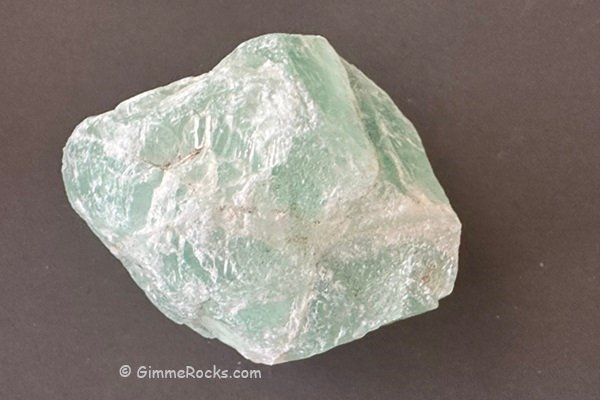
Rocks and Minerals Similar to Fluorite
There are quite a few rocks and minerals that can be mistaken for fluorite. Among them are quartz, calcite, amethyst, and barite. Below, we will provide some valuable tips to help you tell those rocks apart.
Distinguishing Keys
- Quartz: Quartz is harder (7 on the Mohs scale) than fluorite; it lacks cleavage and and fluorescence.
- Calcite: Calcite is softer than fluorite (3 on the Mohs scale); it shows rhombohedral cleavage (vs. cubic in fluorite) and reacts with weak acids.
- Amethyst: Amethyst comes in a single purple color with no strips and bands; it is harder (7 on the Mohs scale) than fluorite and lacks cleavage fluorescence.
- Barite: Barite is softer than fluorite (2.5 on the Mohs scale); it is typically white or colorless and exhibits higher density.
Fluorite Processing Tips
Fluorite is soft, fragile, and has perfect cleavage compared to many other gemstones. Flourite is not recommended for use in jewelry because it tends to chip and break during faceting.
However, massive fluorite crystals work well for carving and making cabochons.
Fluorite can be tumbled. It is, however, considered an advanced material for tumbling. That means specialized steps will be required to process it, compared to a more simplified procedure for other rocks.
Value of Rough Fluorite
Fluorite's value is relatively low due to its softness and the resulting tendency to chip and break during faceting and tumbling.
Several factors will impact the eventual appraisal, including the fluorite's color, clarity, size, crystal formation, and locality.
Rare colors like blue, pink, and yellow contribute to a higher valuation. Multicolored specimens with distinct color zoning or banding are of greater value, too. Larger crystals with well-defined crystal formations also tend to garner a greater valuation.
Rough fluorite can cost $2 - $50 per pound, depending on its quality.
History of Fluorite
Fluorite has been appreciated since ancient times for its beauty and unique properties.
The Romans used it as a flux to lower the melting point of metals, making steel and glass production easier. Its name comes from the Latin word fluere, meaning "to flow."
In England, Blue John, a banded fluorite variety, gained fame in the 18th century for its use in vases, bowls, and other decorative items. It was, however, the French who were ultimately responsible for the mineral's name. In France, they called the mineral bleu jaune (literally, blue-yellow). In England, bleu jaune turned into Blue John.
Fluorite Industrial Uses
Fluorite has many uses across multiple industries.
One of its primary uses is making hydrofluoric acid (HF), essential for creating fluorine-based compounds. Hydrofluoric acid is used for refrigerants, such as chlorofluorocarbons (CFCs) and hydrofluorocarbons (HFCs), that are subsequently used for air conditioning and refrigeration. Fluorite is also used in pharmaceuticals, plastics, and electronic components like semiconductors.
In metallurgy, fluorite is used as a flux in steelmaking, aluminum refining, and other processes. It lowers the melting point of raw materials, making it easier to remove impurities during smelting. Therefore, fluorite is crucial for producing high-quality steel, cement, and glass.
Fluorite is also essential for optical materials. Its transparency and low dispersion make it ideal for high-performance lenses in microscopes, telescopes, and cameras, where reducing color distortion is paramount.
In the chemical industry, fluorite is used for fluoropolymers like Teflon, valued for its nonstick and heat-resistant properties.
In energy production, fluorite-based compounds are used for uranium hexafluoride (UF₆), a key material for nuclear fuel processing.
Finally, fluorite helps prevent tooth decay via fluoride additives to water supplies and dental products, such as toothpaste.
You May Also Like
Reference:
Anthony, J.W., Bideaux, R.A., Bladh, K.W., & Nichols, M.C. (1995). Handbook of Mineralogy. Mineralogical Society of America.
John Farndon, (2018). The Illustrated Guide to Rocks & Minerals. Lorenz Books.

